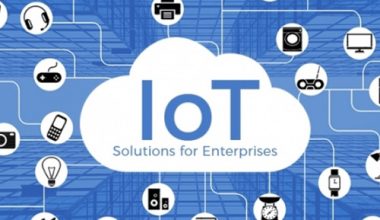The Internet of Things (IoT) is fundamentally an ecosystem of a network of physical objects that have been given sensors, software, and other technological components to enable online communication with other systems and devices.
IoT is quite promising and has been performing spectacularly in a number of industries. Asset management and energy are currently benefiting from IoT.
Asset management is one distinctive element that gives a manufacturing company a competitive edge. Driving superior business operations is the development of IoT-based innovations for asset management.
The three main factors that affect a manufacturing entity’s overall equipment effectiveness (OEE) are availability, performance, and quality.
IoT-powered solutions will assist in monitoring and identifying specific issues, such as missing components, defective regions, and the need for improvement. The company can reach 80% OEE by making these improvements.
Why is IoT adoption crucial for businesses?
As more industries recognize the benefits of IoT, its adoption has exploded. IoT is one of the most popular solutions for businesses considering or now through digital transformation.
Organizations favor IoT-based asset management over traditional asset management because it offers many practical services. IoT-based asset management systems enable efficient asset performance and health monitoring.
Based on the massive amounts of data generated by the smart grid equipment and kept in an asset management system, these management solutions offer crucial insights.
These insights are beneficial since they help with asset maintenance, asset health predictions, agility and responsiveness, operational cost reduction, increased asset reliability, performance, etc.
IoT adoption has accelerated since its inception due to the technology’s growth and development to the point where its installation costs may be reasonable. IoT’s predictive maintenance analysis optimizes asset repair and replacement.
IoT asset management systems are better since they use fewer laborers and follow more automated processes. Asset management technologies based on the Internet of Things (IoT) that simplify tracking strategic costs may also help businesses make sound financial decisions.

These benefits play a significant role in the growing use of IoT in the industry.
The role of IoT in asset management
IoT brings new advantages to asset management since it can create a network of physical objects and connect it to the cloud network. When businesses adopt IoT, the solution combines sensors with all assets and gadgets.
Software, sensors, and networks support these devices, and data is captured and transferred from all sources to a centralized cloud network.
Centralized systems use artificial intelligence and machine learning techniques to analyze the data and produce insightful findings. IoT-based asset management systems allow for increased investment returns, among other benefits.
These are accurately referred to as the next generation of asset management systems.
IoT-Based Asset Management: Key Trends
IoT-powered smart asset management is an advancement above traditional processes. It achieves far more than the conventional methods did. The “one strategic system” created by these cutting-edge smart solutions combines processes and workflows.
Intelligence is contributed via real-time data analysis, alarms, dynamic edge asset control, proactive maintenance, real-time visibility, and automated operations. The following are some of the significant advancements in IoT-based Asset Management:
- Asset Lifecycle Management: Detailed documentation of asset portfolios that maximize the revenue generated by different assets throughout their lifecycle.
- Remote Asset Tracking: IoT leverages cloud-based technology to enable employees to access data on numerous assets from any location and at any time.
- Asset Workflow Automation: Simple and repetitive operations are handled by advanced automation capabilities to quicken business processes, reduce errors, and increase team productivity.
- Asset Health/Condition Monitoring: Cost-effective and preemptive approach of assessing the numerous asset health indicators, with the risks, events, policy execution history, and suggestions for better asset health.
- Predictive Asset Maintenance: Understanding the performance threshold can help you keep an eye out for asset shutdowns and downtime, and you can arrange backup procedures accordingly.
How the IoT can enhance efficiency and save energy costs
We’re at the start of a new era of operational efficiency thanks to the real-time communication and control provided by IoT. In all industries, with ever-evolving technology, continuous improvement and optimization are the only ways to compete successfully in this cutthroat market.
With the help of the Internet of Things, we can gather important, trustworthy real-time data and turn it into knowledge that businesses can use. With the help of this quality, organizations may identify inefficiencies, bottlenecks, excessive resource consumption, etc., and make the best decisions to boost operational efficiency.
As organizations across various industries become more responsive to sustainable energy use practices, IoT, with its smart sensors, actively contributes to putting the smart in smart energy management and cutting energy expenses.
IoT helps businesses use resources more efficiently, reducing unnecessary expenditures and cutting energy costs while improving operational performance. Energy expenditures are significantly reduced due to IoT adoption across all industries, and industrial production has increased significantly.
Metrics to Track the Efficacy Of Asset Management With IoT
- Overall Equipment Effectiveness (OEE): OEE is the most used statistic for monitoring plant efficiency and is a component of every plant manager’s KPI. It determines the proportion of the whole process spent in highly productive manufacturing. Manufacturers might learn a lot about how to maximize productivity by tracking OEE.
- Asset uptime and downtime: One of the most critical measures to lower maintenance costs is asset uptime and downtime. The goal is to thoroughly analyze the data to improve uptime, decrease downtime, and achieve optimal use.
- Cost-effectiveness and Asset Optimization: Preventive maintenance reduces OpEx, and capital expenditures (CapEx) are decreased by lengthening the lives of the equipment and making better use of the assets.
In Summary
Asset management is made possible through IoT-based asset tracking, which boosts a company’s operational efficiency. It can also be used to develop new business models for monitoring the performance of assets over the course of their whole lifecycle. Additionally, it aids businesses in finding areas where they can reduce costs.
Adopting technology that enables you to make more sensible and optimal business decisions in light of the market’s rapid evolution is crucial.
Asset management is an essential component of any business, so one must embrace IoT technologies enabling organizations to maximize the performance, availability, and quality of their assets and resources.



